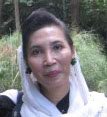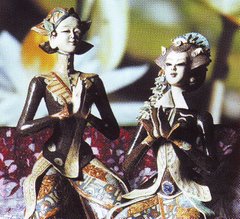Marching brass Putri Santa Ursula
Sonya Monica dearest, this is for you
EFFECTS OF LOW POWER LASER IN FROZEN SHOULDER
Wyasa Andrianto,MD, Ferial Hadipoetro,MD,PhD, Nury Nusdwinuringtyas,MD,
Zuljasri Albar,MD,; Nyoman Murdana,MD, Suryanto Hartono,MD,MA,
Frozen shoulder :
• disorder of progressive pain and decrease of range of motion of shoulder articulation
• the main causation of shoulder pain and dysfunction in the middle and older age population
• treatment option:
• ice cooling, medicaments, exercise, TENS, ultrasound diathermy
• Low power laser therapy with exercise will decrease shoulder pain and increase the range of motion of the shoulder articulation
• improve the quality of life of patients with frozen shoulders
• Design comparison of parameter before and after therapy of frozen shoulder patients
• OPD Rehab.Med.,Rheumatology Div,Dept.Internal Med,
• December 2004 to April 2005
• Frozen shoulder patients not less than 18 years of age
• VAS not less than 8
• Cooperative
• Informed consent
• Cases with trauma of shoulder articulation
• Rheumatoid arthritis and spondyloarthritis with shoulder involvement
• Following or under corticosteroid injection therapy within the last 3 months
• Patients with abduction range of motion less than 90 degree
• patients with contraindication of laser therapy
• patients who are unable to perform shoulder exercise properly
Laser device
• Wavelength : 830 nm
• Output : 30 mW
• Dose : 30 J per treatment
• Continuous wave
• 3 times per week for 3 weeks
DATA ANALYSIS
Table 1.
Group distribution of frozen shoulders
by age
| Age(year) | Total | Percentage |
| 40 – 50 51 – 60 61 – 70 | 1 2 13 | 6,25 12,5 81,25 |
Table 2.
Group distribution of frozen shoulders by sex
| Sex | Total | Percentarge |
| Male Female | 6 7 | 46,15 53,85 |
Table 3.
Group distribution of frozen shoulders
by education level
| Education level | Total | Percentage |
| Elementary School Junior High School Senior High School College University | 3 1 3 2 3 4 | 18,75 6,25 18,75 12,5 18,75 25 |
Table 4.
GROUP DISTRIBUTION OF
FROZEN SHOULDER BY PROFESSION
| PROFESSION | TOTAL | PERCENTAGE |
| PRIVATE HOUSEWIFE RETIRED/JOBLESS NURSE TEACHER | 4 6 4 1 1 | 25 37,5 25 6,25 6,25 |
Table 5.
GROUP DISTRIBUTION OF FROZEN SHOULDERS
ACCORDING TO DURATION OF SICKNESS
| DURATION | TOTAL | PERCENTAGE |
| <> ³ 2 months | 3 13 | 18,75 81,25 |
Table 6.
GROUP DISTRIBUTION OF
FROZEN SHOULDERS BY LOCATION
| Location affected | Total | Percentage |
| Left shoulder Right shoulder | 9 7 | 56,25 43,75 |
Table7.
VAS BEFORE AND AFTER TREATMENT OF
FROZEN SHOULDER
| VAS SCORE | MEAN± SD | n = 16 | p |
| VAS (pre) VAS (post) |
8,6875 ± 0,8237 1,4125 ± 0,9142 | |
0,000 |
Graphic 1.
Graphic : Declining VAS score (shoulder joints)
Graphic 2.
Graphic : Increasing joint movements (shoulder joints)
RESULTS AND DISCUSSION
• Significant decrement of shoulder pain before and after treatments following 3 weeks of therapy
• Significant increment of range of motion of shoulder articulations before and after treatments of low power laser therapy with shoulder exercises following 3 weeks of therapy
CONCLUSIONS
• LOW POWER LASER THERAPY AND EXERCISES OF SHOULDER ARTICULATION IS EFFECTIVE AND EFFICIENT MODALITIES TO TREAT FROZEN SHOULDER







2 comments:
Congratulation for the fruitful result of this research!We are proud of the principal investigator,supervisor and all members of the supporter team.The paper had been awarded honourable prize from The Indonesian Society for Laser Medicine,August 2006 (Hotel Santika,Jakarta).Comment by:L.S.Handikin.MD,President,The Indonesian Society for Laser Medicine.
Thank you . We waiting your future invitation.
Post a Comment